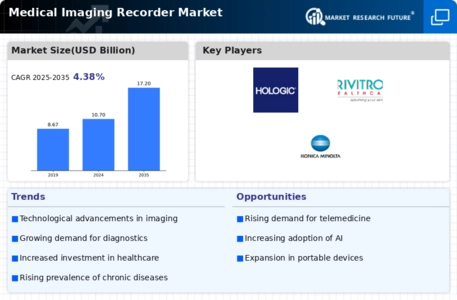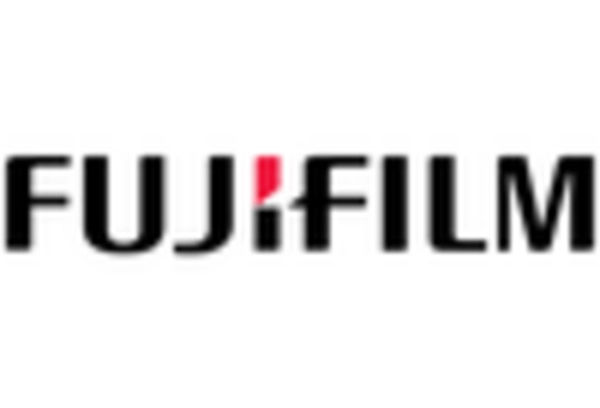Rising Demand for Diagnostic Imaging
The Medical Imaging Recorder Market is witnessing a notable increase in the demand for diagnostic imaging services. As healthcare providers strive to improve patient outcomes, the reliance on accurate and timely imaging has become paramount. The World Health Organization indicates that the global burden of diseases is rising, leading to an increased need for diagnostic imaging to facilitate early detection and intervention. This trend is expected to drive the market for medical imaging recorders, as healthcare facilities seek to enhance their imaging capabilities. Furthermore, the expansion of outpatient imaging centers and the growing trend of telemedicine are likely to contribute to the increased utilization of imaging services, thereby boosting the demand for advanced recording solutions.
Growing Focus on Preventive Healthcare
The Medical Imaging Recorder Market is significantly influenced by the growing focus on preventive healthcare. As healthcare systems shift towards proactive approaches, the demand for imaging services that facilitate early diagnosis and monitoring of diseases is increasing. Preventive healthcare strategies emphasize the importance of regular screenings and check-ups, which often rely on advanced imaging techniques. This trend is supported by various health campaigns and initiatives aimed at raising awareness about the benefits of early detection. Consequently, healthcare providers are investing in medical imaging recorders to enhance their diagnostic capabilities and meet the rising demand for preventive services. The emphasis on preventive healthcare is likely to drive sustained growth in the medical imaging recorder market.
Regulatory Support and Funding Initiatives
The Medical Imaging Recorder Market benefits from supportive regulatory frameworks and funding initiatives aimed at enhancing healthcare infrastructure. Governments and health organizations are increasingly investing in healthcare technologies, including medical imaging, to improve diagnostic capabilities. For instance, various funding programs are being established to support the acquisition of advanced imaging equipment and recording solutions. This financial backing is likely to stimulate market growth, as healthcare providers are more inclined to adopt innovative technologies. Additionally, regulatory bodies are implementing standards that promote the use of high-quality imaging solutions, further driving the demand for medical imaging recorders. The combination of regulatory support and funding initiatives is expected to create a conducive environment for market expansion.
Increase in Research and Development Activities
The Medical Imaging Recorder Market is experiencing growth due to an increase in research and development activities within the healthcare sector. Academic institutions and private companies are investing in R&D to develop innovative imaging technologies and recording solutions. This focus on innovation is driven by the need for improved diagnostic tools that can provide more accurate and efficient results. Recent studies indicate that the global healthcare R&D expenditure is expected to rise, which will likely benefit the medical imaging sector. As new imaging modalities and recording technologies emerge from these research efforts, the demand for medical imaging recorders is anticipated to grow, reflecting the industry's commitment to advancing healthcare solutions.
Technological Advancements in Imaging Equipment
The Medical Imaging Recorder Market is experiencing a surge in demand due to rapid technological advancements in imaging equipment. Innovations such as high-resolution imaging, 3D imaging, and real-time data processing are enhancing diagnostic accuracy and efficiency. The integration of advanced imaging modalities, including MRI, CT, and ultrasound, is driving the need for sophisticated recording solutions. According to recent data, the market for medical imaging equipment is projected to grow at a compound annual growth rate of approximately 5.5% over the next few years. This growth is likely to be fueled by the increasing prevalence of chronic diseases and the rising geriatric population, which necessitates advanced imaging solutions for effective diagnosis and treatment.


















Leave a Comment